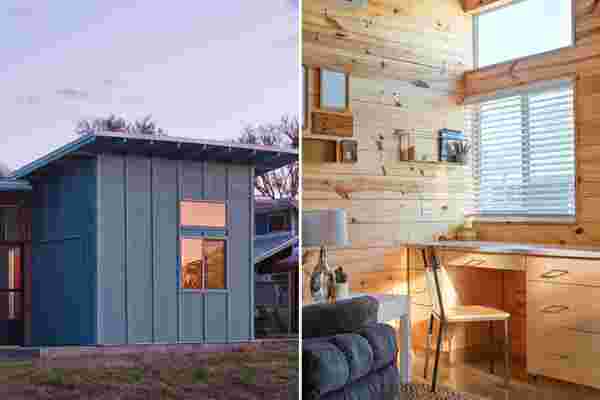
Beginning in 1998, a mobile food truck based in Austin, Texas, with the help of thousands of volunteers, has helped serve food to unhoused individuals seven days a week and 365 days a year. That food truck has since transformed into Mobile Loaves & Fishes, a social outreach ministry responsible for the development of “the most talked-about neighborhood” in Austin, Texas, Community First! Village. The village is one of MLF’s three core programs that were started to serve the unhoused population of Austin, Texas, and offers permanent and sustainable housing for an affordable price in a mutually supportive community.
Teaming up with Bailey Eliot Construction, McKinney York Architects, an architecture firm based in Austin, recently designed and constructed a micro-home for one of the residents of Community First! Village. In order to meet the new homeowner’s tiny housing criteria, McKinney York Architects planned to design a micro house that met both the homeowner’s requirements for privacy and the village’s commitment to community support. The home’s final design incorporates a butterfly roof, which implements the use of a central valley where the two pitched roofs meet to collect rainwater for further irrigation use. Additionally, installing a butterfly roof allows for plenty of natural lighting to enter through the windows without having an impact on the homeowner’s privacy.
Taking full advantage of the 200 square foot area limit for each micro-home, McKinney York Architects also installed a screened-in sunroom for the homeowner to have the option of either opening the screens up to the rest of the community or keeping them closed for optimal privacy. Inside the home, original pine timber lines the walls, giving the feel of a blank canvas for the homeowner to leave as is or design as they’d like. The tiny home manages to include a bedroom with room for a twin-sized or larger bed, a modest kitchen, a relatively spacious working area, dining space, and a cozy den for relaxing.
Community First! Village is a 51-acre development planned by MLF over the course of two phases which spanned over four years and has expanded to include a total of 500 tiny homes as well as community amenities such as gardens and behavioral healthcare facilities. In 2014, the first phase of Community First! Village commenced after Tiny Victories 1.0, a design competition in partnership with Mobile Loaves & Fishes and AIA Austin DesignVoice, invited firms to design sustainable, tiny housing solutions that take up no more than 200 square feet. Following the first phase, which culminated with a 27-acre master-planned community for the “chronically homeless” population of Central Texas, the village’s second phase kicked off in 2018. Today, Community First! Village offers permanent housing and encourages a safe, uplifting community space for more than 250 formerly unhoused individuals.
Designer: Mobile Loaves & Fishes , McKinney York Architects , and Bailey Eliot Construction
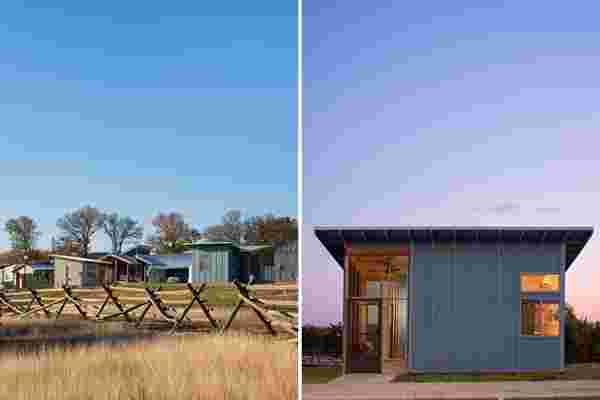
Hell Yes! It’s another Lamp!
To celebrate (or mock) the opening of the newest New York City museum, called appropriately enough, “New Museum”, designer Sherwood Forlee brings you this scaled down version in lamp form dubbed “New Lamp.” Disappointed by the lack of light being emitted by this new structure, Sherwood took Mihoko Ouchi’s original building design and added an extra dose of luminescence. I think I will stick with my scaled down Statue of Liberty lamp. It’s French and gives off a nice green glow.
Designer: Sherwood Forlee
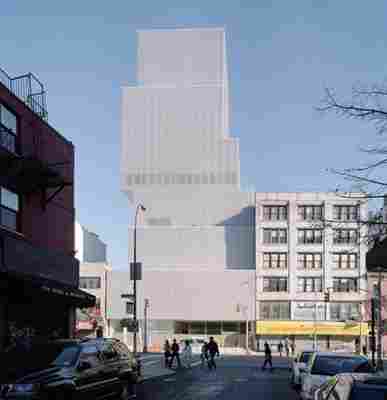
Picture of the “New Museum”

These Balinese cabins use natural materials and minimal design to immerse guests in the environment!
{"title":"This Balinese cabin's design is infused with local materials + modern architecture : 2","author_name":"Yanko Design","author_url":"https://www.youtubeom/channel/UCVohuIZpji5uTdzychBxKcw","type":"video","height":"591","width":"1050","version":"1.0","provider_name":"YouTube","provider_url":"https://www.youtubeom/","thumbnail_height":"360","thumbnail_width":"480","thumbnail_url":"https://i.ytimgom/vi/VjMfTZeIb8k/hqdefault.jpg","html":"<iframe width="1050" height="591" src="https://www.youtubeom/embed/VjMfTZeIb8k?feature=oembed" frameborder="0" allow="accelerometer; autoplay; clipboard-write; encrypted-media; gyroscope; picture-in-picture" allowfullscreen></iframe>","arve_cachetime":"2021-03-05 09:06:40","arve_url":"https://youtu.be/VjMfTZeIb8k","arve_srcset":"https://i.ytimgom/vi/VjMfTZeIb8k/mqdefault.jpg 320w, https://i.ytimgom/vi/VjMfTZeIb8k/hqdefault.jpg 480w"}
We are out of 2020, but since things are more or less the same with the gloomy global mood I have continued to find cabins that can uplift us all – this one quite literally will! The Eibche by Shomali Design takes the cabin game to a new level by incorporating the best of Balinese culture, modern architecture, and cozy interiors.
The elevated structure weaves concrete and bamboo into its design. The team has used locally sourced building materials – wood for the structure and a brick-stone combination for the foundation. The frame is then ‘cemented’ by concrete which brings in a hint of modern minimalist architecture. The designers chose organic materials in order to create harmony with the environment so Eibche showcases a lot of bamboo poles, woven bamboo, coconut wood, and teak wood in both the interior as well as exterior.
“As Balinese people traditionally use tripartite divisions, we tried to hold the spirit of this format and use it in a modern way. On the other hand, splitting the cabin in half with the separating walls allowed nature to move inside. Using natural materials encouraged us to hold their color. No natural colors were altered and the only addition we made was a white wash to make their harmony and contrast pop more. Residents can now be immersed in the scenic setting even if they are indoors,” says Yasser Shomali. The Eibche cabin has managed to blend the contrasting aesthetics of a tropical mood board with contemporary architecture and has not disturbed the delicate balance between them – it all looks like it was born from the Balinese land.
Designer: Shomali Design Studio
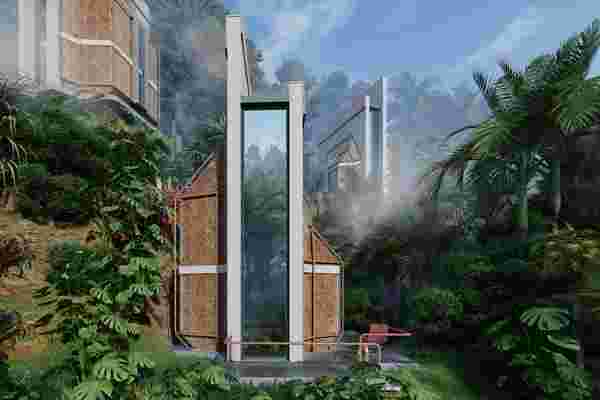
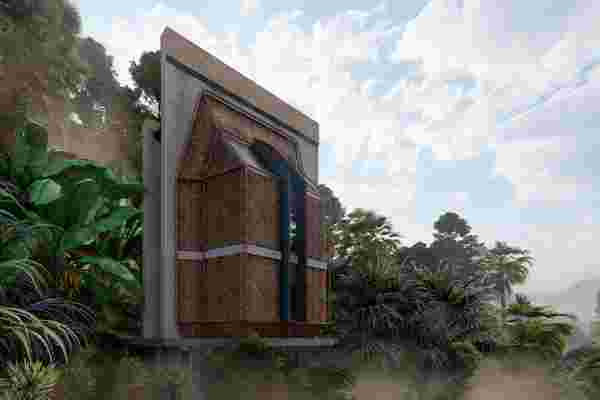
{"title":"This Balinese cabin's design is infused with local materials + modern architecture","author_name":"Yanko Design","author_url":"https://www.youtubeom/channel/UCVohuIZpji5uTdzychBxKcw","type":"video","height":"591","width":"1050","version":"1.0","provider_name":"YouTube","provider_url":"https://www.youtubeom/","thumbnail_height":"360","thumbnail_width":"480","thumbnail_url":"https://i.ytimgom/vi/s6q2t1ZBLno/hqdefault.jpg","html":"<iframe width="1050" height="591" src="https://www.youtubeom/embed/s6q2t1ZBLno?feature=oembed" frameborder="0" allow="accelerometer; autoplay; clipboard-write; encrypted-media; gyroscope; picture-in-picture" allowfullscreen></iframe>","arve_cachetime":"2021-03-05 09:06:40","arve_url":"https://youtu.be/s6q2t1ZBLno","arve_srcset":"https://i.ytimgom/vi/s6q2t1ZBLno/mqdefault.jpg 320w, https://i.ytimgom/vi/s6q2t1ZBLno/hqdefault.jpg 480w, https://i.ytimgom/vi/s6q2t1ZBLno/sddefault.jpg 640w, https://i.ytimgom/vi/s6q2t1ZBLno/maxresdefault.jpg 1280w"}








